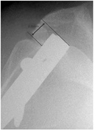Abstract
Purpose
To evaluate the post-operative functional reduction of the shoulder joint and the impacting factors to post-operative shoulder joint function in interlocking IM nailing treatment of humeral shaft fracture.
Materials and Methods
From April 1999 to August 2004, 35 patients (35 cases) whom admitted to hospital for humeral shaft fracture and treated using interlocking intramedullary nail were followed up for more than 1 year. 1 year post-operative shoulder joint function were evaluated using American Shoulder Elbow Surgery Scale (ASES). Pre-operative shoulder joint pain, radiologically degenerative change and extent of nail protrusion were evaluated, and each factor was correlated with function of the shoulder joint.
Results
33 cases out of 35 cases showed union and average union period was 12 weeks. Complications consisted of 2 cases of nonunion, 1 case of infection, 1 case of loosening of distal fixing screw, 1 case of radial nerve palsy and 1 case of axillary nerve palsy. Shoulder joint function 3 months after operation : mean ASES score 78.2, 12 months after operation : mean ASES score 89.6. Pre-operative shoulder joint pain and nail protrusion showed to be statistically related to shoulder joint function.
Figures and Tables
 | Fig. 2(A) shows a sclerotic articular surface, (B) shows a narrowing articular space and degenerative osteophyte (arrow head). |
References
1. Bae SW, Kim WJ, Song BY, Choi NH, Lee JH. Postoperative functional assessments in adult humerus shaft fractures-comparison among plates and screws, intramedullary nail and external fixator. J Korean Soc Fract. 2001; 14:228–235.

2. Bell MJ, Beauchamp CG, Kellam JK, McMurtry RY. The results of plating humeral shaft fractures in patients with multiple injuries. The Sunnybrook experience. J Bone Joint Surg Br. 1985; 67:293–296.

3. Brumback RJ, Bosse MJ, Poka A, Burgess AR. Intramedullary stabilization of humeral shaft fractures in patients with multiple trauma. J Bone Joint Surg Am. 1986; 68:960–970.

4. Chapman JR, Henley MB, Agel J, Benca PJ. Randomized prospective study of humeral shaft fracture fixation: intramedullary nails versus plates. J Orthop Trauma. 2000; 14:162–166.

5. Crates J, Whittle AP. Antegrade interlocking nailing of acute humeral shaft fractures. Clin Orthop Relat Res. 1998; 350:40–50.

6. Habernek H, Orthner E. A locking nail for fractures of the humerus. J Bone Joint Surg Br. 1991; 73:651–653.

7. Hems TE, Bhullar TP. Interlocking nailing of humeral shaft fractures: the Oxford experience 1991 to 1994. Injury. 1996; 27:485–489.

8. Hunter SG. The closed treatment of fractures of the humeral shaft. Clin Orthop Relat Res. 1982; 164:192–198.

9. Ikpeme JO. Intramedullary interlocking nailing for humeral fractures: experiences with the Russell-Taylor humeral nail. Injury. 1994; 25:447–455.

10. Ingman AM, Waters DA. Locked intramedullary nailing of humeral shaft fractures. J Bone Joint Surg Br. 1994; 76:23–29.
11. Matsen FA 3rd, Ziegler DW, DeBartolo SE. Patient self-assessment of health status and function in glenohumeral degenerative joint disease. J Shoulder Elbow Surg. 1995; 4:345–351.

12. McCormack RG, Brien D, Buckley RE, Mckee MD, Powell J, Schemitsch EH. Fixation of fractures of the shaft of the humerus by dynamic compression plate or intramedullary nail. A prospective, randomized trial. J Bone Joint Surg Br. 2000; 82:336–339.
13. Modabber MR, Jupiter JB. Operative management of diaphyseal fracture of the humerus. Plate versus nail. Clin Orthop Relat Res. 1998; 347:93–104.
14. Richards RR, An KN, Bigliani LU, et al. A standardized method for the assessment of shoulder function. J Shoulder Elbow Surg. 1994; 3:347–352.

15. Riemer BL, Butterfield SL, D'Ambrosia R, Kellam J. Seidel intramedullary nailing of humeral diaphyseal fractures: a preliminary report. Orthopedics. 1991; 14:239–246.
16. Robert VG, John T, Frazier W. Open reduction and internal fixation of humeral shaft fractures. J Bone joint Surg Am. 1986; 68:430–433.
17. Robinson CM, Bell KM, Court-Brown CM, McQueen MM. Locked nailing of humeral shaft fractures. Experience in Edinburgh over a two-year period. J Bone Joint Surg Br. 1992; 74:558–562.

18. Rommens PM, Verbruggen J, Broos PL. Retrograde locked nailing of humeral shaft fractures. A review of 39 patients. J Bone Joint Surg Br. 1995; 77:84–89.

19. Rupp RE, Chrissos Mg, Ebraheim NA. The risk of neurovascular injury with distal locking screws of humeral intramedullary nails. Orthopedics. 1996; 19:593–595.
20. Shin HD, Rhee KJ, Kim KC, Song HS. Operative treatment of traumatic humeral shaft fracture. Comparision of interlocking IM nailing and plate fixation by posterior approach. J Korean Fract Soc. 2005; 18:93–99.

21. Stern PJ, Mattingly DA, Pomeroy DL, Zenni EJ Jr, Kreig JK. Intramedullary fixation of humeral shaft fractures. J Bone Joint Surg Am. 1984; 66:639–646.

22. Varley GW, Radford P. Locked intramedullary nailing of the humerus The Nottingham experience of the seidel nail. J Bone Joint Surg Br. Suppl I. 1993; 75:34–39.




 PDF
PDF ePub
ePub Citation
Citation Print
Print






 XML Download
XML Download